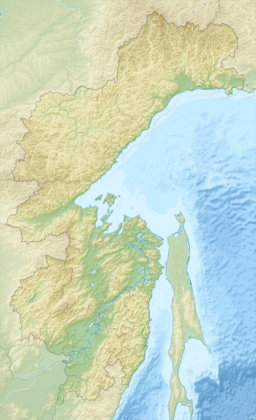Bokon
| Bokon | |
|---|---|
| Бокон | |
 Lake Bokon Sentinel-2 image | |
Location in Khabarovsk Krai, Russian Far East | |
| Location | Khabarovsk Krai |
| Coordinates | 54°19′44″N 134°10′12″E / 54.32889°N 134.17000°E |
| Type | Freshwater lake |
| Primary outflows | Bokonchan |
| Catchment area | 39.8 km2 (15.4 sq mi) |
| Basin countries | Russia |
| Max. length | 6 km (3.7 mi) |
| Max. width | 4 km (2.5 mi) |
| Surface area | 14.8 km2 (5.7 sq mi) |
| Surface elevation | 126 m (413 ft) |
| Islands | None |
Lake Bokon (Template:Lang-ru) is a large freshwater lake in Khabarovsk Krai, Russia. It has an area of 14.8 km2 (5.7 sq mi) and a maximum depth of 6 m (20 ft).[1] There are no permanent settlements on the shores of the lake.[2]
According to local folklore, the lake is haunted by a beautiful and virtuous Evenk girl who was magically swallowed by the icy lake. She dwells in the bottom and legend tells that occasionally she may appear above the surface.[3]
Geography
The lake is part of the basin of the Uda river, Tuguro-Chumikansky District. Bokon is the largest lake in the district. It is located below the slopes of the northwestern side of the Taikan Range. River Bokonchan, a right tributary of the Uda, is the outflow of the lake.[4]
The area is covered in snow in late October, thawing takes place in May.[5]
 |
Flora
The banks of the lake are low and swampy, overgrown with marsh vegetation, such as horsetail and sedges, as well as scattered shrubs near the shores.[6]

